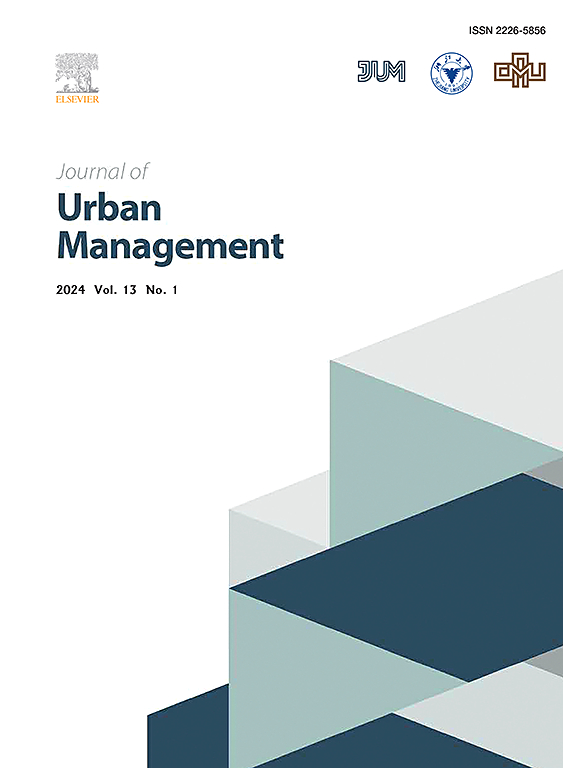应用pareto边界理论和球树算法优化可持续发展山地城市的增长边界
IF 5
2区 社会学
Q1 URBAN STUDIES
引用次数: 0
摘要
山地城市地形的复杂性往往限制了城市新增用地的合理布局和集聚分布。为此,本文提出了一种创新的城市增长边界优化模型——帕累托边界理论和球树算法优化模型(SP-BT)。该模型以新增城市用地为agent,以城市景观紧凑度和城市建设适宜性两个目标为基础,对斑块位置进行动态优化。SP-BT模型的独特之处在于其最优搜索和更新过程始终沿着帕累托前沿展开,实现了城市土地集聚与适宜性之间的平衡。此外,与适宜性最优评价模型(SOE)、元胞自动性人工神经网络(ANN-CA)和蚁群优化模型(ACO)相比,该模型具有参数设置简化、演化速度快、输出结果灵活、碎片整理效果好等优点,特别适用于地形条件复杂的山地城市。在以巴中市为例的实证研究中:(1)SP-BT模型显著提高了城市景观斑块的平均大小,从8.86增加到22.74-95.88,城市总适宜性下降幅度控制在3.14%。(2) SP-BT模型在处理山地城市规划方面表现突出,特别是在减少景观破碎化方面,适用于山地环境下的实际城市规划。总体而言,本文提出的模型为山地城市复杂地形条件下新建土地利用优化问题提供了高效、灵活的解决方案,具有重要的实际应用价值,可以为规划者提供更加科学实用的决策支持工具。本文章由计算机程序翻译,如有差异,请以英文原文为准。

Applying pareto frontier theory and ball tree algorithms to optimize growth boundaries for sustainable mountain cities
The terrain complexity of mountain cities often limits the rational layout and agglomeration distribution of newly added urban land. To this end, this paper proposes an innovative urban growth boundary optimization model —— Pareto Frontier theory and Ball-Tree algorithm optimized model (SP-BT). By treating newly added urban land as agents, the model dynamically optimizes the land patch locations based on the two goals of urban landscape compactness degree and suitability for urban construction. The SP-BT model is unique in that its optimal search and update process always unfolds along the Pareto front, achieving a balance between urban land agglomeration and suitability. In addition, compared with Suitability Optimum Evaluation Model (SOE), Artificial Neural Network in Cellular Automata (ANN-CA), and Ant Colony Optimization Model (ACO), the model has simplified parameter setting, fast evolution speed, flexible output results, and excellent defragmentation effect, especially suitable for mountain cities under complex terrain conditions. In the empirical study taking Bazhong city, China as an example: (1) SP-BT model significantly increased the mean size of urban landscape patch from 8.86 to 22.74–95.88, and the decrease of urban total suitability was controlled at 3.14%. (2) The SP-BT model excels in handling urban planning in mountainous cities, particularly in reducing landscape fragmentation, making it suitable for practical urban planning in mountainous environments. In general, the model proposed in this paper provides an efficient and flexible solution to the problem of new land use optimization under the complex terrain conditions of mountainous cities, which has important practical application value and can provide planners with more scientific and practical decision support tools.
求助全文
通过发布文献求助,成功后即可免费获取论文全文。
去求助
来源期刊

Journal of Urban Management
URBAN STUDIES-
CiteScore
9.50
自引率
4.90%
发文量
45
审稿时长
65 days
期刊介绍:
Journal of Urban Management (JUM) is the Official Journal of Zhejiang University and the Chinese Association of Urban Management, an international, peer-reviewed open access journal covering planning, administering, regulating, and governing urban complexity.
JUM has its two-fold aims set to integrate the studies across fields in urban planning and management, as well as to provide a more holistic perspective on problem solving.
1) Explore innovative management skills for taming thorny problems that arise with global urbanization
2) Provide a platform to deal with urban affairs whose solutions must be looked at from an interdisciplinary perspective.
 求助内容:
求助内容: 应助结果提醒方式:
应助结果提醒方式:


